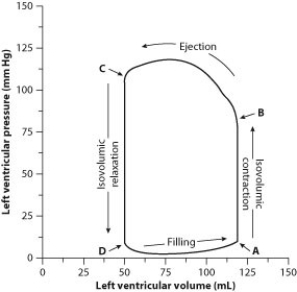To evaluate cardiac function, scientists and physicians measure both the pressure and the volume inside the heart. When both pressure and volume data are plotted on the same graph, the resulting graph is called a pressure-volume loop. To create a pressure-volume loop, a catheter (a thin tube) is inserted into the vessels of the heart, and measurements of both left ventricular pressure and left ventricular volume are taken. The data are plotted on a graph, and cardiac function can then be evaluated from the distribution of the data and the shape of the loop.
The following figure shows a typical left ventricle pressure-volume loop for a healthy young adult. The cardiac cycle proceeds counterclockwise. Each complete turn around the loop (for example, starting at point A and ending back at point A) represents one complete cardiac cycle.

-At what point on the diagram does the aortic valve (the semilunar valve that separates the left ventricle and the aorta) open?
Definitions:
LH
LH, or Luteinizing Hormone, is a hormone produced by the anterior pituitary gland, playing a key role in regulating the menstrual cycle and ovulation in females, and testosterone production in males.
Uterine Tube
A pair of tubes leading from the ovaries of female mammals into the uterus, through which the egg travels during ovulation.
Scarring
The process through which wounds heal, leaving permanent fibrotic changes in the tissue.
Surgical Procedure
A medical intervention involving an incision with instruments, performed to repair damage, remove diseased tissue, or improve function.
Q6: When mice are learning to run on
Q8: The structural and functional unit of nervous
Q18: Like humans, cats can experience kidney failure.
Q26: Individuals medically diagnosed with "dry eyes" experience
Q37: Which of the following statements regarding infertility
Q45: Which respiratory structure likely has the largest
Q50: During exercise, your heart rate can increase
Q51: Mice that lacked the MyRF genes (P-MyRF
Q58: Which group of animals is the most
Q62: What part of the brain sorts incoming